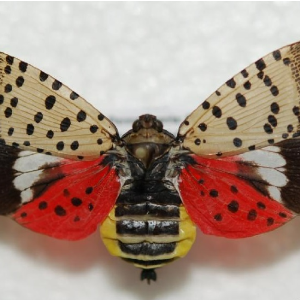
March 16, 2023 | Montpelier, VT - The spotted lanternfly (Lycorma delicatula) is an invasive planthopper that is native to parts of Asia. It was first detected in the U.S. in Pennsylvania in 2014. Established populations of spotted lanternfly (SLF) exist in 14 states. Vermont does not have an established population of SLF at this time, but the insect is an excellent hitchhiker and may make its way to the Green Mountain state.
Identification
Spotted lanternfly adults are about an inch long and a half-inch wide, with a yellow and black body and grey wings that are spotted black. Smaller, younger life stages vary in appearance, ranging from black with white spots to red and black. Research indicates that SLF egg masses can survive winter temperatures of -10 °F. Adult SLF are vulnerable to frosts, and though hard frosts are arriving much later than they used to, sometimes well into October, that will still help to curtail populations of SLF that try to make a home in VT. Go to www.VTinvasives.org for more information on SLF and for reference images.
Impact
Studies show that the insects move around so the impact of their feeding gets dispersed. Their feeding can slow the development of plants, including crops like cucumbers, and can increase the drop rate of stone fruits. Small, young trees are more likely to sustain damage. They are also known to irreparably damage vineyards.
In addition to direct damage to plants, these large planthoppers secrete honeydew, like aphids do. Unlike tiny aphids, the amount of SLF secretions is substantive and will attract stinging insects and sooty mold, potentially causing property damage. SLF are a big nuisance in the states that have them. They are mobile, and by the time you call a pest control operator to spray them, SLF will have moved on.
Hosts Plants
In 2020, Lawrence Barringer, the state entomologist for PA and his colleague, Claire Ciafrè, reviewed host plants of the SLF. They found that SLF feeds on at least 103 species of plants worldwide, of which 56 are found in the US. Their preferred host is tree-of-heaven, (TOH), Ailanthus altissima. Knowing where TOH is in Vermont will help focus survey and detection efforts on locations of their preferred host. Vermont citizens can help us determine how much and where our TOH populations are by learning how to ID that plant (look for glands at the base of the leaves) and reporting it on www.iNaturalist.org. Learn how to identify Ailanthus.
If you think you’ve found spotted lanternfly, take a photo, capture the insect and freeze it and report it.
More Resources
- SLF webinar hosted by VAAFM. Guest: NH State Plant Regulatory Official, Piera Siegert
- SLF Over View for Green Industry
- USDA-APHIS Pest Information
- Host Plant List Barringer and Ciafre

